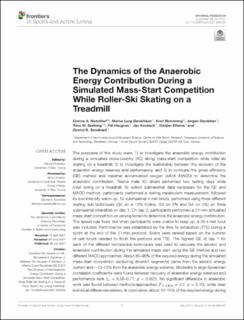| dc.description.abstract | The purposes of this study were: 1) to investigate the anaerobic energy contribution during a simulated cross-country (XC) skiing mass-start competition while roller-ski skating on a treadmill; 2) to investigate the relationship between the recovery of the anaerobic energy reserves and performance; and 3) to compare the gross efficiency (GE) method and maximal accumulated oxygen deficit (MAOD) to determine the anaerobic contribution. Twelve male XC skiers performed two testing days while roller skiing on a treadmill. To collect submaximal data necessary for the GE and MAOD method, participants performed a resting metabolism measurement, followed by low-intensity warm up, 12 submaximal 4-min bouts, performed using three different skating sub-techniques (G2 on a 12% incline, G3 on 5% and G4 on 2%) on three submaximal intensities on day 1. On day 2, participants performed a 21-min simulated mass-start competition on varying terrain to determine the anaerobic energy contribution. The speed was fixed, but when participants were unable to keep up, a 30-s rest bout was included. Performance was established by the time to exhaustion (TTE) during a sprint at the end of the 21-min protocol. Skiers were ranked based on the number of rest bouts needed to finish the protocol and TTE. The highest GE of day 1 for each of the different inclines/sub-techniques was used to calculate the aerobic and anaerobic contribution during the simulated mass start using the GE method and two different MAOD approaches. About 85–90% of the required energy during the simulated mass-start competition (excluding downhill segments) came from the aerobic energy system and ~10–15% from the anaerobic energy systems. Moderate to large Spearman correlation coefficients were found between recovery of anaerobic energy reserves and performance rank (rs = 0.58–0.71, p < 0.025). No significant difference in anaerobic work was found between methods/approaches (F(1.2,8.5) = 3.2, p = 0.10), while clear individual differences existed. In conclusion, about 10–15% of the required energy during the periods of active propulsion of a 21-min simulated mass-start competition came from the anaerobic energy systems. Due to the intermittent nature of XC skiing, the recovery of anaerobic energy reserves seems highly important for performance. To assess the anaerobic contribution methods should not be used interchangeably. | en_US |

